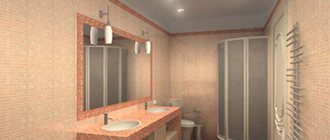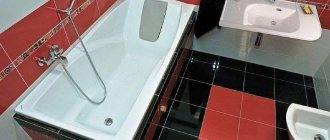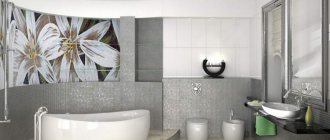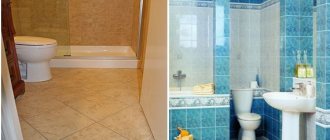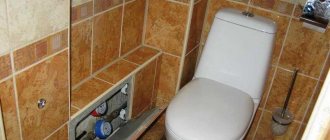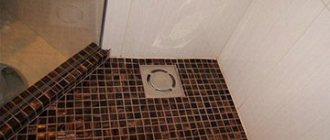Home / Tips
Back
Published: 04/28/2020
Reading time: 3 min
0
1212
It is natural for a person to arrange his home, while he strives to hide all utility networks as much as possible. In connection with this, the question is increasingly being asked on the Internet about whether it is possible to install a boiler in the bathroom.
In fact, this conclusion suggests itself to every developer when determining the option for installing boilers in a small house or apartment.
In practice, everything does not look so simple. The reason for this is the fact that there are still discrepancies on this issue in some state regulations.
In addition, there are established minimum standards for the size of the room, which is the starting point when deciding on installing a boiler in the bathroom.
- 1 Why a boiler in the bathroom
- 2 Rules and regulations 2.1 Reasons for prohibiting installation in the bathroom and toilet
- 2.2 Is it possible to bypass the ban?
- 2.3 What is provided for unauthorized installation
What types of heating devices are not suitable for a bathroom?
Types of equipment prohibited for installation in such premises include any gas units: water heaters, boilers, convectors. Therefore, the relevant services will most likely give a negative answer to the question of whether it is possible to install a gas boiler in the bathroom.
Gas boilers
According to government standards and regulations, such devices are not intended for indoor use.
It is not permitted to operate water heating devices powered by gas and equipped with open combustion chambers in rooms with forced ventilation. Although heating devices require good air exchange for proper functioning, the installation of supply fans cannot be combined with such equipment. The combustion process is disrupted, combustion products accumulate and there is a risk of poisoning with harmful substances. It is permitted to install such devices only in certain cases.
Gas water heater in the bathroom
As a rule, gas equipment specialists do not even agree to replace old products with newer ones.
Is it possible to install a boiler in a toilet?
You cannot install gas equipment in a toilet without official permits. However, under certain conditions, you can obtain permission to install such units.
Installation of a floor-standing gas boiler
If you are wondering whether it is possible to install a gas boiler in a bathroom or toilet, you need to consider the following requirements:
- Redevelopment of the premises and changes to technical documentation. When the Gas Service does not provide registration of the relevant heating equipment, you can try to change the status of the premises. “Converting” a bathroom into a storage room or change room and submitting an appropriate application to the BTI will immediately help solve the problem. If the technical passport of a house or apartment indicates the appropriate types of premises, there will be no refusal from government agencies. However, the presence of plumbing fixtures may result in a ban on the installation of a heating boiler. If only the toilet has been installed in the room, changing the plan will not cause any difficulties.
- Connecting new gas equipment . Provided that registered heating equipment is mentioned in the design of the premises, there will be no problems with installing a new boiler. It is much easier to replace an old device with a new one if permission for similar devices is already available.
Gas service technicians in some regions of our country may agree to install certain water heating systems in sanitary facilities. These must be special devices with a closed combustion chamber. Before selecting and installing such equipment, you must consult with gas specialists.
Wall-mounted gas boiler
Answers from experts
Generous:
it is possible but is it necessary? another place can be found
Yuri Morozenkov:
Would you like to wash between the pipes?
Ivan Kuleshov:
Theoretically, it is possible, this particular Ariston has an IP X4D protection class, you can hang it in the bathroom. Another question is whether the area of the room allows this to be done.
Maria:
You will not meet the requirements for the dimensions of the room and the presence of fresh ventilation - windows with a window. Or more precisely, ask your gas workers; anyway, you will draw up the project and have it certified by them.
Vladimir Petrov:
Here I am reading the passport for a boiler with a closed combustion chamber. They can be located in the bathroom in zone 3 at a distance of min. 60cm from the edge of the bathtub or shower. And you need to ground current-carrying parts in accordance with CSN 33 2000-4. So you can bet. If only the bathroom wall faced the street, the exhaust would flow.
Truculentus:
6.37.* Installation of water heaters, heating boilers and heating devices should be provided in kitchens and non-residential premises intended for their placement and meeting the requirements of paragraphs. 6.42 * and 6.43 . THE INSTALLATION OF THE SPECIFIED DEVICES IN BATHROOMS IS NOT ALLOWED. The issue of the need to move gas water heaters from bathrooms, in which they were placed in accordance with previously existing standards, to kitchens or other non-residential premises of a residential building during the reconstruction of a house or gas supply system, should be decided on a case-by-case basis by the design organization in agreement with local operating organizations gas industry. In existing residential buildings, it is allowed to provide for the installation of gas heating appliances and heating devices in corridors for individual use that meet the requirements of paragraphs. 6.42 * and 6.43 .
The distance from the protruding parts of gas burners or fittings to the opposite wall must be at least 1 m.
Verik:
I don’t see a problem with this... hang it up, there’s protection there
Spitz Pomeranian:
I agree with Verkisto. The gas service will not allow it.
Henry Hayes:
A friend of mine has an Aristonov wall mount (genus with a boiler) installed in the bathroom. But they have a private house according to the Ind. project built and a bathroom with a total area of 9 square meters. So - if the space allows, then hang the boiler wherever you want.
Vyacheslav:
)))))))))))))) why not ask the organizations that give permission?
AVR TECH:
no, it's better to put it in the kitchen
Cafe bar Ermak:
The gas boiler MUST be placed in a room where there is natural ventilation (window)
Truculentus:
Can be installed in the bathroom if this room meets the requirements for installing a gas boiler. Details about the requirements: SP 42-101-2003 SNiP 42-01-2002
Alexei:
and in the requirements... room area... separate entrance... glazing area... free access for maintenance personnel... inflow cross section...
It’s better to place the bathroom in the same room as the instantaneous boiler. The water will be regulated faster by the tap)))
Tatyana Otmakhova:
I doubt that the VDPO will sign the act. Call the VDPO in your city, they will tell you everything in detail.
Vlad:
Where in the project (BTI documents) it should be there. Otherwise, redevelopment. With mandatory approval from the gas supply organization. 99 percent of the time they won’t give it. What did you write about above?
How to understand the documentation
The situation with permission to carry out installation is somewhat complicated by confusion in the official documentation. The fact is that the adopted Codes of Norms and Rules do not provide a clear explanation of whether gas boilers are allowed in bathrooms. Many employees of the state gas service refer to regulation 2.04.08 –87. It says about the ban on connecting gas boilers in bathrooms.
However, according to the resolution of the State Construction Committee of the Russian Federation dated December 23, 2002, the above documents and norms are considered invalid.
The new requirements (document 42-01-2002) do not contain clear instructions or a strict ban on the installation of gas equipment. As a result, misunderstandings arise. Some employees of the Gas Service simply refuse to install heating gas structures, without delving into the intricacies of the adopted documents and standards.
The process of installing and connecting a gas boiler
Without paperwork and collecting a large number of various permits, you can only install a new gas boiler or water heater in place of old appliances in the bathroom. In this case, if a place for such equipment is already provided, and, therefore, there is also permission, the employee will agree to make the connection.
Requirements for premises according to SNiP
The installation of gas equipment in the bathroom is regulated by SNiP. Document 2.04.08-87 mentions a direct ban on the installation of heating devices in such buildings.
Studying the latest edition of the act SP 402.1325800.2018, you can see clause 5.6, which states that it is prohibited to install gas-using devices in bathrooms and bathrooms.
To protect the system from moisture, copper pipes are used.
Regardless of the features of the model, the equipment includes metal parts that are subject to oxidation when interacting with moisture. To protect the system from such phenomena, pipes made of copper or metal-polymer materials are used. If the rules are not followed, the unit will quickly wear out, increasing the likelihood of an explosion.
For speakers
Gas water heaters are potentially dangerous devices. Therefore, the room where the boiler will be installed must meet the strict fire safety requirements specified in SNiP and SP, as well as in the official recommendations of equipment suppliers.
The main regulatory restrictions include the following:
- The ceiling height is from 2 m.
- The room has a supply and exhaust or natural ventilation system, which ensures effective air replacement.
- The total area of the room is at least 12 square meters. m.
- The room has a window or window that opens.
The bathroom must meet strict requirements.
Any non-residential buildings that meet the listed requirements are suitable for the boiler room. Technical restrictions vary based on regional specifications. Therefore, before installing the column, you should familiarize yourself with the regulations in force in your locality.
The regulations indicate that the equipment should be fixed at a distance of at least 25-30 cm from the ceiling. A distance of 80-120 cm is maintained between the floor covering and the body.
For gas boilers
Domestic gas boilers can be installed in those premises that meet the following requirements:
- Area from 4 sq. m.
- Entrance door from 80 cm wide.
- Good lighting (0.3 sq.m of glazing per 10 cubic meters of space).
- Ceilings from 2.5 m high.
- Availability of a ground loop.
- Access to cold water pipes.
- The presence of a chimney, the cross-section of which corresponds to the performance of gas-using equipment.
Domestic gas boilers can be installed in rooms with an area of 4 square meters.
m. In addition, the surface of the walls in the boiler room must be leveled and plastered.
Some nuances of installing flow-through gas heaters in the toilet and bathroom
For owners of private cottages, there is another way to obtain official permission to install a boiler or gas heater in the bathroom. First, official documentation is drawn up when developing the project.
Install gas equipment in the part of the home where it is permitted. Then plumbing fixtures, such as a bathtub, are installed next to the fixture and a plasterboard partition is built around it. Such an improvised redevelopment, of course, cannot be called ideal. Subsequently, if the owner wants to sell the house, a number of problems may arise. Specialists from the Bureau of Technical Inventory will be able to conduct an examination only after dismantling the walls.
Officially, installation of a gas boiler is provided only for technical premises - storage rooms, change houses. If such rooms meet the requirements adopted for them, the installation of gas-fired water heaters is permitted.
Appearance of a floor-standing gas boiler
High levels of humidity in the bathroom and temperature fluctuations often lead to breakdowns of gas heating appliances. Before deciding to install it, it is worth considering all the advantages and disadvantages and assessing the financial feasibility of installing such equipment. Obtaining official permission from the relevant authorities is not easy; this can be done by applying some legal tricks.
The procedure for obtaining permission to install and connect to the gas main
- We go to the local gas distribution organization (Gorgaz, Oblgaz, Rayongaz, etc.), fill out and submit an application for the installation of a gas boiler. As for documents, you must have your passport and any evidence of ownership of the house with you. On average, after a week, technical specifications (TU) - this is permission to install the boiler.
- In the local housing and communal services or fire inspection authorities, we find out the contacts of the organization involved in checking chimneys and ventilation ducts, and invite specialists for inspection. If the chimney meets all the requirements, experts will issue a conclusion on the proper condition of the chimney , otherwise - a list of necessary changes. In practice, this item is not mandatory in all regions and gas workers often accept a boiler without it; details can always be found in the gas service.
- After receiving the specifications, you can order a project from any of the certified bureaus or from the same Gorgaz. In addition to the specifications, the compilation requires accurate data on the models of the gas boiler and meter. It is not necessary to buy them at this stage, but you need to decide on the model for sure, since making changes to an already finished project is impossible.
- With all the documents available at this stage (specifications, design, conclusion on the condition of the chimney), we go to Gorgaz, where we coordinate the project and conclude a contract for servicing the gas boiler unit. Now you can begin installing the boiler yourself or with the help of a gas service.
- After installation is completed, all that remains is to invite the gas service to accept the work performed, connect the boiler to the gas main, and carry out commissioning work.
Registration of a gas boiler is a rather lengthy bureaucratic process, lasting on average 2-3 months. It is recommended to start registration in April-July.
Gas boilersInstructionsBoilers
Installation of gas stoves in bathrooms
According to the documentation on working with heating systems, in the section on residential multi-storey buildings there are no clear prohibitions on the installation of this type of equipment.
Thus, a gas water heater in the bathroom is a completely suitable way to heat water.
Geyser on the wall in the bathroom
However, according to accepted state requirements, it is necessary to take into account many nuances when choosing a gas unit and when installing such a design. It is necessary to take into account the specific layout of the bathroom.
Certain provisions of the Code of Norms and Rules dated January 31, 2003 provide for the installation of gas equipment with a closed chamber type in multi-apartment buildings in the absence of such buildings being connected to a central or individual heat supply system .
At the same time, heat sources and water heaters using natural fuel are allowed to be connected in some rooms. This is specified in paragraph 7.3.8. SNiP. In addition, the total thermal power of such devices, according to the rules, is no more than one hundred kilowatts.
Gas boiler diagram
It is allowed to install similar devices in kitchen units, the amount of energy converted should not exceed thirty-five kilowatts.
Such gas equipment can only be installed in premises of a certain type. According to official documents, the room must have a light opening. When calculating glazing, certain standards must be met. So, for one cubic meter of room there should be approximately 0.03 square meters of glass. It is also necessary to ensure effective ventilation.
The total volume of the room must be at least 15 m3. These parameters are related to the safety and comfort of using heaters and carrying out work on their installation. The height of the room is at least 220 cm. It is necessary that the passages in the room remain free. Their minimum size should reach seventy centimeters.
Features of kitchen renovation and design with a gas water heater
When planning the design and renovation of a kitchen with a gas heater, you need to take into account fire safety rules, ventilation and ergonomic requirements. Here are some important tips to help you design your workspace in the best possible way.
- If you are equipping a kitchen from scratch, then it is advisable to think about the location of the gas water heater, layout and interior design even before renovating and purchasing furniture. Then you will have more room for maneuver and fewer problems. For example, you can move the speaker, change it to a more modern model or one that suits the future environment, improve the ventilation and chimney at the same time, adjust the color scheme of the interior to match the speaker, etc.
- It is advisable to purchase a kitchen set to order, regardless of whether you plan to build the water heater into a cabinet or not. This will allow you to arrange your headset without errors and use every centimeter to your advantage.
- Is it possible to install a suspended ceiling in a kitchen with a gas water heater? It is possible if the height of the room with the sheet installed is at least 2.25 m, and there remains a distance of at least 8 cm from the chimney opening to the ceiling. In this case, it is advisable to equip the chimney not with an aluminum corrugated pipe, which gets very hot, but with a sandwich chimney with thermal insulation layer. This way, the ceiling will not be damaged by heat (from combustion products going into the chimney) and will not itself become an obstacle to draft. If necessary, the chimney opening can be lowered slightly.
- The walls in a kitchen with a gas water heater should not be decorated with wallpaper or plastic panels (at least near the water heater), as these materials can deteriorate/melt under the influence of heat. Ideally, the walls should simply be plastered, painted or finished with ceramic tiles (see photo).
Small kitchen with geyser and walls lined with ceramic tiles
- In a kitchen with a gas water heater, a constant flow of fresh air is required (50-90 cubic meters per hour). This is necessary both for your safety and for the combustion stability of the unit. Therefore, when installing plastic windows, choose those that have a micro-ventilation function, that is, special fittings that allow you to open windows with micro-slots from 3 to 7 mm. Both in winter and in summer, kitchen windows with a gas water heater should be opened in this mode. If wooden windows are planned or have already been installed in the kitchen, then due to their natural micro-slits the issue of passive ventilation will be resolved by itself. The main thing is not to overdo it with waterproofing, seals and window insulation.
- Supply ventilation valves embedded in the wall, for example, Kiv-125 or KPV-125, will help ensure air flow even more effectively. It is advisable to take care of their installation before repairs, so as not to spoil the finish.
- In a kitchen with a gas water heater, both the supply and exhaust systems must work in a balanced manner. Therefore, it is necessary to invite professional ventilation specialists to check the chimney and ventilation duct. If necessary, they need to be put in order. And, of course, when arranging your kitchen, do not make the most serious and, unfortunately, common mistake - do not cover the ventilation duct with plasterboard boxes, wallpaper, or furniture.
- And the last piece of advice - “in any unclear situation,” consult the gas service and act in accordance with the requirements of regulatory documents.
Additional installation conditions
It must be remembered that placing gas appliances in the basements of apartment buildings is prohibited. When installing, you must follow the following rules from clause 7.3.8:
- Gas units and heat generators are mounted on walls made of non-flammable or low-flammable materials .
- The installation must be carried out so that the gaps between the device and the wall are at least 3 cm .
- The finishing of walls near the heat generator must be made of fireproof materials .
- The facing coating must extend beyond the unit body by no less than 10 cm .
- For floor-standing equipment, additional fire safety measures must be taken. The floor surface where the heat generator is installed should be covered with special non-flammable materials . This area must be arranged so that it extends beyond the body of the gas appliance by at least 10 cm.
The official regulatory document on heating, ventilation devices and air conditioning 41 – 01–2003 in the section on heat supply systems provides rules for the installation and operation of gas appliances, as well as technical conditions for rooms where such equipment is connected.
Gas water heater
In residential multi-storey buildings and various outbuildings, it is necessary to install heat generators with a sealed combustion chamber and automatic safety devices. Such devices stop the flow of gas when the power suddenly goes out, the protection circuits break down, when the burner malfunctions or when the pressure in the coolant decreases significantly. Sometimes an automatic emergency shutdown is necessary when there is poor smoke removal or other equipment malfunctions.
According to existing standards, units whose power does not exceed thirty-five kilowatts are allowed to be installed in the kitchen or hallway.
Gas heating equipment in the kitchen
Appliances with heating output exceeding the specified norm must be installed in separate extensions. The total power of such equipment should not exceed one hundred kilowatts according to the standards.
The supply of oxygen for combustion processes must occur through the air duct. It must be placed on the street side for equipment with a sealed chamber. And for open-type heat generators, air is taken from the very room in which the installation was carried out. These requirements are listed in paragraph 6.2.4 of SNiP.
Provision 6.2.5 of this document states that the chimney must be positioned vertically. In this case, it is not allowed to reduce the cross-section of the smoke exhaust pipe. It cannot be laid in residential premises.
In the room where the heat generator with a sealed combustion chamber is located, it is necessary to equip general exchange ventilation, the calculation of which should be at least 1 exchange per hour.
When installing devices with an open combustion chamber, it is necessary to take into account the air flow for fuel combustion. The ventilation design prevents vacuum, which affects the removal of smoke from the heat generator.
Designs for masking the boiler
At the initial stage, it should be taken into account that manufacturers of water heaters provide at least an average level of decorative value for the body of the water heater, meaning its installation on walls or on the floor without additional camouflage.
Thus, choosing a ready-made cabinet for a bath, hallway, kitchen or corridor, inside which a water heater will ideally fit, without gaps and dismantling some shelves, is a very difficult task. Since the owner does not yet have either a cabinet or a boiler, he runs around the shops and compares their mutual dimensions until they are completely compatible.
The exception is “under the sink”, “under the sink” boilers installed in floor cabinets. However, they are all low-power, since it is physically impossible to stuff large-volume tanks into small-sized furniture.
Therefore, structures inside which a storage water heater can be hidden are usually built by a home craftsman himself.
Box
A box is a structure that protrudes outward relative to the plane of the wall. Roughly speaking, this is a cabinet made of gypsum plasterboard sheets screwed onto a frame made of galvanized profile. Unlike a cabinet, the structure is stationary and non-removable. Instead of a door for access to the interior, an inspection hatch is used - hinged, sliding, push-button, removable.
The box manufacturing technology is as follows:
- fastening, piping the water heater (this will be problematic to do later);
- fixing the guide profile;
Attaching the starting profile.
- installation of a rack profile;
- frame assembly;
Frame installation
- installation of an inspection hatch;
- covering the frame with plasterboard;
Fastening gypsum board sheets.
- finishing of external surfaces with tiles.
The box can be vertical from the ceiling to the floor or half the length of the wall, horizontal, stepped, of a complex configuration, depending on where the water supply and boiler are located.
Niche behind the toilet
Unlike the previous option, the niche is sewn up with one panel; there are no sides.
Material consumption is reduced and the labor intensity of the process is reduced.
A popular way to disguise engineering systems and water heaters in the niche behind the toilet are blinds, as in the bottom photo.
Pipes may interfere with fixing the electrical appliance to the wall using standard fasteners. In this case, brackets or special fastening systems are used.
Adjustable fastening system made of profile perforated pipe with brackets.
In this case, a stepped box is used, the wall is built up only above the toilet.
Niche under the kitchen window
Step-by-step instructions for hidden installation of a storage water heater in a niche under a kitchen window are as follows:
- dismantling standard doors, shelves lining internal surfaces;
- sewerage, electrical, water supply installations;
- finishing niche surfaces;
- installation of a water heater, installation of engineering systems;
- installation of inspection hatch, sliding and swing doors, blinds.
Access to the water heater body is necessary in order to clean the tank from scale and change the anodic protection electrodes.
Mezzanine
In the standard version, the mezzanine shelf is used to store household items. In this case, the purpose of this architectural structure changes. The shelf is equipped with blinds or doors, and a storage boiler is installed on it. The sequence of operations for manufacturing a mezzanine for a water heater is as follows:
- horizontal mark on opposite walls of the corridor;
- fastening bars or profiles to walls;
- laying the shelf on profiles/bars;
Installation of the mezzanine step by step.
- installation of doors or blinds;
- installation of a water heater, connection to the electrical network, water supply, sewerage.
Installation of the boiler on the mezzanine.
Attention: Only horizontal models of water heaters must be installed on the mezzanine. It is not allowed to lay vertical boilers on their sides.
Wall cabinet
The option of installing a single-circuit electric boiler in an industrially manufactured wall cabinet is the least labor-intensive, but the most costly in terms of finances. The main installation nuances are:
- the standard cabinet fasteners will not support the weight of a storage heater with a full tank of water;
- the boiler is attached directly to the wall, either through the back wall of the furniture, or after its dismantling;
- to connect to sewerage, cold water, and hot water circuits, it is best to install water sockets inside the cabinet on the wall of the room;
- To connect to a 220 V network, an electrical outlet with grounding is inserted into the cabinet in the same way.
Plastic and composite pipes are always cheaper than long flexible metal hoses and last several times longer.
Closet
The interior solution “boiler inside a wardrobe” is optimal for a corridor or hallway. It is in these rooms that such furniture is used most often, and they are located in close proximity to the bathroom and kitchen. You can connect to the sewer/water supply through the wall. To do this, the back or side wall of the wardrobe must be the enclosing structure of a bath, toilet or kitchen.
The design of the built-in wardrobe is extremely simple - the doors move from ceiling to floor on rollers along guides, there are no side or rear walls. The upper part of one furniture compartment is allocated for the boiler; standard shelves for storing things are installed in the remaining space.
Floor stand
Due to the small size of bathroom cabinets and floor cabinets for kitchen sinks, it is impossible to fit a large-volume storage single-circuit electric boiler inside this furniture. Single-door cabinets accommodate a device with a maximum 30 liter tank, double-door cabinets - with a 80 liter tank.
Water heaters are installed on a cabinet shelf or attached to the wall of the room, and may have legs.
Official rules for installing gas water heaters in the bathroom
In many respects, a bathroom water heater is a prohibited type of water heating equipment. Taking into account the conditions given in the official documentation of utility services, we can conclude that such instantaneous heaters are not intended for connection in the bathrooms of standard apartments.
Modern geysers
State standards require a room of at least 15 m³ in volume for the installation of gas equipment, and standard bathrooms are usually significantly smaller. To install the speaker, it is necessary to ensure good ventilation of the room. The minimum permissible area of a bathroom window according to the established standards should be 0.45 m². However, in most cases, the bathrooms of typical apartments do not have windows facing the street and there is no need to talk about high-quality ventilation of the room.
Therefore, bathrooms are not designed to use gas water heaters. Installation of such equipment is possible only if the premises are redeveloped in accordance with the requirements of the state gas service.
Gas boilers Gas water heater in the bathroom Installation of a floor-standing gas boiler Wall-mounted gas boiler The process of installing and connecting a gas boiler Appearance of a floor-standing gas boiler Gas water heater on the wall in the bathroom Gas water heater Gas heating equipment in the kitchen Modern gas water heaters Gas boiler diagram
Boiler with voltage stabilizer
White geyser
Geyser in the bathroom interior
